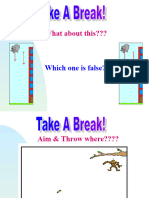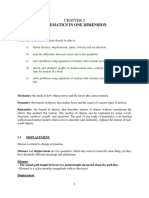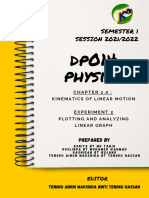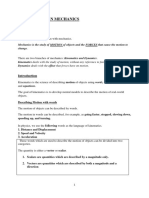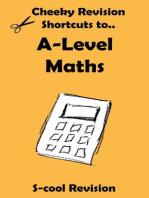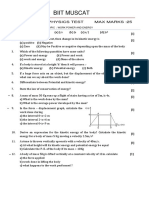Unit 1 Notes
Uploaded by
kkoutsothodorosUnit 1 Notes
Uploaded by
kkoutsothodorosAP Physics C: Mechanics
Unit 1: Kinematics
Section 1.1 – Introduction to Kinematics……………………………………………………...…………4
Section 1.2 – Free Fall………………………………………………………………………………….10
Section 1.3 – Vectors…………………………………………………………………………………...15
Section 1.4 – Relative Motion……….………………………………………………………….………19
Section 1.5 – Projectile Motion…………………………………………………………………...…….21
Section 1.6 – Motion in a Circle…………………………………………………………………..……25
3
AP Physics C: Mechanics Unit 1 - Kinematics
1.1 Motion in One Dimension (Chapter 2)
Focus Question: How are displacement, acceleration, and velocity related?
Motion occurs whenever an object changes position. Unlike dynamics, which is the study of motion and
forces, kinematics only considers the motion of objects without any regard to force. Kinematics is
focused with looking at how vector and scalar quantities change while a particle is in motion.
Understanding the difference between scalar (distance, speed, etc.) and vector (displacement, velocity,
acceleration, etc.) quantities is key to kinematics.
Scalars are quantities that only have a magnitude assigned to them, while vectors have direction and
magnitude. Displacement is a scalar quantity and is given by ∆𝑥 = 𝑓𝑖𝑛𝑎𝑙 𝑝𝑜𝑠𝑖𝑡𝑖𝑜𝑛 − 𝑖𝑛𝑖𝑡𝑖𝑎𝑙 𝑝𝑜𝑠𝑖𝑡𝑖𝑜𝑛,
while distance is simply the length of the path traveled.
*For example, suppose Goku goes from point A to point C, then to point B. His distance is 14, since he
travels 10 in the positive direction to get to B, and 4 in the negative direction to get to point B. However,
displacement is 6.
Calculate average and instantaneous velocity.
Speed is the rate at which an object covers distance, while velocity is the rate of change of displacement. An
object’s average velocity can be found over a time interval using the endpoints. In Physics C, the instantaneous
velocity can also be found by taking the instantaneous rate of change of position.
Average Velocity Instantaneous Velocity
* In Physics C, “Speed” can mean two different things:
Average speed is found simply by 𝑠𝑝𝑒𝑒𝑑 = , or by taking the magnitude of the average velocity
vector.
Instantaneous speed is the magnitude of the instantaneous velocity vector.
4
Important rules for positive vs. time graphs
The slope of the graph represents velocity.
*slope is change in y over change in x, ∆𝑦/∆𝑥, not y/x.
A line means constant velocity.
A horizontal line means the object is at rest.
A parabola means constant acceleration.
When the graph crosses the x-axis the object is at the origin.
*A position vs. time graph does not show the shape of an object’s trajectory.
Example A: Ponder the position vs. time graph shown below. At which point(s) is velocity?
a) constant?
This occurs anywhere where there is a straight line. B, D, E
b) zero?
This is where position is not changing (a horizontal line) B
c) negative?
This occurs when slope is negative D
d) undefined?
Slope is undefined at sharp curves, which occurs at C
e) At which points are speed decreasing?
Speed is decreasing when the magnitude of the slope is decrease,
which occurs at A
Calculate average and instantaneous velocity.
Acceleration – Rate of change of velocity.
Average Acceleration Instantaneous Acceleration
5
Important rules for velocity vs. time graphs
The slope of the graph represents acceleration. The area under the graph represents displacement.
A line means constant acceleration. A horizontal line means constant velocity.
When the graph crosses the x-axis the object switches direction.
Relationship between Velocity and Acceleration
If velocity and acceleration have the same sign, an object is motion is speeding up.
𝑎 > 0, 𝑣 > 0 : speeding up in positive direction
𝑎 < 0, 𝑣 < 0 : speeding up in negative direction
𝑎 > 0, 𝑣 < 0 : moving in negative direction and slowing down
𝑎 < 0, 𝑣 > 0 : moving in positive direction and slowing down
*On a velocity vs time graph, speed is increasing when a graph is moving away from the x-axis and is
decreasing when the graph approaches the x-axis.
Solve for kinematic quantities when acceleration is constant.
When acceleration is constant, the 5 kinematic equations from Physics 1 can be used. When given a problem to
solve for an unknown quantity, find a kinematics equation that contains both the unknown and the known
quantities. Each equation contains four quantities and can be classified by the quantity not in the equation.
1. No acceleration: The no acceleration kinematic equation simply states that displacement of an object during a
certain frame of time is the average velocity multiplied by the amount of time:
𝒗𝒊 + 𝒗𝒇
∆𝒙 = ( )∆𝒕
𝟐
2. No displacement: The no displacement formula comes from the definition of acceleration:
∆𝑣 𝑣 − 𝑣
𝑎= = → 𝒗𝒇 = 𝒗𝒊 + 𝒂∆𝒕
∆𝑡 ∆𝑡
3. No final velocity: Equation 2 can be written as to find the velocity as some time, 𝑣(𝑡), as 𝑣(𝑡) = 𝑣 + 𝑎𝑡.
Since velocity is the rate of change of position, the displacement can be found by integrating the velocity
function.
𝟏
∆𝑥 = 𝑣𝑑𝑡 → ∆𝑥 = ( 𝑣 + 𝑎𝑡)𝑑𝑡 → ∆𝒙 = 𝒗𝒊 ∆𝒕 + 𝒂∆𝒕𝟐
𝟐
𝟏
4. No initial velocity: Rearranging equation 2 and then integrating gives: ∆𝒙 = 𝒗𝒇 ∆𝒕 − 𝒂∆𝒕𝟐
𝟐
5. No time: The no time equation can be derived by combing (1) and (2):
Solving (2) for t: ∆𝑡 =
𝒗𝒊 𝒗𝒇
Plugging this result into (1): ∆𝑥 = → ∆𝑥 = → 𝒗𝟐𝒇 = 𝒗𝟐𝒊 + 𝟐𝒂∆𝒙
𝟐
6
Example B: A Hyundai Elantra is travelling to Homeplus at 32 m/s when it brakes with constant deceleration.
It takes the car 9 seconds to stop.
a) What is the acceleration?
Since the acceleration is constant, the kinematics equations can be used.
Known variable: 𝑣 = 32 , ∆𝑡 = 9 𝑠, 𝑣 = 0 (𝑐𝑎𝑟 𝑠𝑡𝑜𝑝𝑠)
Unknown variable: 𝑎
Equation that relates the variables: 𝑣 = 𝑣 + 𝑎∆𝑡
Solving the equation for acceleration: 𝑎 =
∆
𝒎
𝑎= = −𝟑. 𝟔 𝟐; the acceleration is negative since the object has positive velocity and is
𝒔
slowing down.
b) What is the car’s stopping distance?
Since 4 kinematics quantities are known, any of the equations that include displacement can be used.
Since the object in car in this problem is always moving in the positive direction, the distance is equal to
the displacement.
)
∆𝑥 = ∆𝑡 = ( (9 𝑠) = 𝟏𝟒𝟒 𝒎
Example C: In order to satiate his extreme need for speed, Faisal drives down Southern Boulevard at 36 m/s.
At one instant, he passes the car of a concerned police officer. The police car starts from rest to pursue with a
constant acceleration of 3.0 m/s2.
a) How long will it take the police officer to catch the delinquent speeder?
Both Faisal (F) and the Police Officer (P) start at the same position. The police officer will catch up to
Faisal when they have equal positions.
Faisal’s position function - Faisal has constant velocity, so his position is simply his velocity times time:
𝑥 (𝑡) = 32𝑡
Police Officer’s position function: The police officer starts at rest and has constant acceleration, so one
of the kinematic equations is to be used:
𝑥 (𝑡) = 𝑣 𝑡 + 𝑎𝑡 → 𝑥 (𝑡) = 𝑡
Equating the position functions and solving for the time when they are equal:
𝑥 (𝑡)=𝑥 (𝑡) → 32𝑡 = 𝑡 → 𝑡 = 𝟐𝟏. 𝟑 𝒔
7
b) How far will the police car have traveled?
𝑥 (𝑡) = 𝑡 = (21.3 𝑠) = 681 𝑚
c) How fast is the police officer traveling when he catches up?
Since the police officer starts from rest with constant acceleration of 3, his velocity as a function
of time is given as 𝑣 (𝑡 ) = 𝑣 + 𝑎𝑡 → 𝑣 (𝑡 ) = 3𝑡
𝑣 (𝑡 ) = 3(21.3 𝑠) = 𝟔𝟒 𝒎/s
Solve for kinematic quantities when acceleration is not necessarily constant.
If acceleration varies as a function of time, the kinematics equations are not valid. However, calculus is:
Velocity is the derivative of position: 𝑣 =
Acceleration is the first derivative of velocity and the second derivative of position: 𝑎 = =
Reversing the process used to find 𝑣(𝑡) or 𝑎(𝑡), you can integrate 𝑣(𝑡) to find 𝑥(𝑡) or 𝑎(𝑡) to find 𝑣(𝑡).
To find maxima and minima, look at end points and critical points (points where the slope is zero).
Example D: A at x = 5 m is traveling at 2 m/s at time t = 0 s. It moves with an acceleration given by
𝑎(𝑡) = 2 𝑡−3 .
a) Find a function for v(t).
𝑣(𝑡) = ∫ 𝑎(𝑡)𝑑𝑡 = 𝑡 − 3𝑡 + 𝐶
Since v(0) = 2 m/s, C = 2, making the velocity function: 𝒗(𝒕) = 𝒕𝟐 − 𝟑𝒕 + 𝟐
b) Find the minimum velocity of the particle.
To find the minimum velocity, the points where the slope changes signs (where the derivative of
velocity is zero) must be found. In addition, this must be compared to the endpoints. There is no
endpoint on the right, but t = 0 is an endpoint.
8
𝑣 (𝑡) = 2𝑡 − 3 = 0. 𝑣 (𝑡) = 0 at 𝑡 = , so a relative extrema occurs at this point.
𝑣 = −3 + 2 = −.25
Since the function is a parabola that opens up and the endpoint is v(0) 2 m/s, -.25 m/s is the minimum
value of the velocity.
c) Find a function for x(t).
𝑥(𝑡) = ∫ 𝑣(𝑡)𝑑𝑡 = 𝑡 − 𝑡 + 2𝑡 + 𝐶
𝟏 𝟑
Since x(0) = 5 m, C = 5, making the position function: 𝒙(𝒕) = 𝒕𝟑 − 𝒕𝟐 + 𝟐𝒕 + 𝟓
𝟑 𝟐
d) At what time is the particle closest to the origin (x=0)?
𝑥 (𝑡) = 𝑡 − 32 − 2 = 0
→ (𝑡 − 2)(𝑡 − 1) = 0, 𝑡 = 1, 2
There are relative extrema at t = 1 and t = 2
𝑥(1) = (1) − (1) + 2(1) + 5 = 5.8 𝑚
𝑥(2) = (2) − (2) + 2(2) + 5 = 5.7 𝑚
These values must also be compared to the endpoint at t = 0.
𝑥(0) = 5 𝑚
Since the starting position is smaller than the two relative extrema, the initial value is the absolute
minimum value of the position.
Rate your understanding: Kinematics
0 1 2 3 4
AP Physics C? Cool, they I can solve kinematics I can set up and solve I can set and solve I can explain and teach
put my grade right in the equations with help. kinematics problems kinematics problems kinematics.
course title! with minor errors. with no errors.
9
AP Physics C: Mechanics Unit 1 - Kinematics
1.2 Free Fall (Chapter 2)
Focus Question: What accelerates falling objects?
Objects falling toward earth have constant acceleration that is independent of mass:
A free body diagram of an object that is freely falling will only have a single force on it, which is gravity
acting downwards:
Using Newton’s 2nd Law (𝐹 = 𝑚𝑎):
𝑚𝑎 = 𝑚𝑔
𝑎=𝑔
Therefore, any object that is airborne with no other forces on it will experience a constant acceleration of
g, where g = 9.81 m/s2 downwards, independent of the object’s mass.
Some “Formulas” *you should know how to derive the following
-Time in the air for dropped object:
Consider an object dropped from rest form a height of h. Down is taken as the
positive direction since it is the only direction of motion.
Variables: ∆𝑦 = ℎ, 𝑎 = 𝑔, 𝑣 = 0, 𝑡 =?
Equation that results the variables: ∆𝑦 = 𝑣 𝑡 + 𝑎𝑡
𝟐𝒉
Solving for time: ℎ = 𝑣 𝑡 + 𝑔𝑡 → 𝒕 =
𝒈
-Time in the air for an object thrown up:
For the entire motion of an object that is thrown up from a certain height,
and lands at the same height, the vertical displacement is zero.
Additionally, if there is no air resistance, the object will have the same
speed as it launch (but opposite sign) when it hits the ground (due to
conservation of energy).
Variables: ∆𝑦 = 0, 𝑎 = −𝑔, 𝑣 = 𝑣, 𝑣 = −𝑣 𝑡 =?
Equation that results the variables: 𝑣 = 𝑣 + 𝑎𝑡
𝟐𝒗
Solving for time: 𝑡 = = →𝒕=
𝒈
-Velocity at max height:
At max height, the object’s velocity is switching direction from upwards to downwards, so there is a short
instant at max height where the velocity is instantaneous equal to zero.
*The speed is only zero in the y-direction, an object with a horizontal component of velocity will stay have
that horizontal component at max height.
-Max height:
Variables: 𝑣 = 𝑣, 𝑎 = −𝑔, 𝑣 = 0, ∆𝑦 =?
Equation that results the variables: 𝑣 = 𝑣 + 2𝑎∆𝑦
Solving for displacement: ∆𝑦 = = → ∆𝑦 =
( )
*This is displacement at max height for an object thrown up at initial speed of 𝑣. If a problems asks for
“max height”, this value needs to be added to the initial height.
10
Graphs for an object thrown straight upwards
◾Position vs. time graph
*The graph is parabolic since any object in the air with only gravity (a=-g) acting
will have a displacement given by ∆𝑦 = 𝑣 𝑡 − 𝑔𝑡 , which is a quadratic function.
*The max height occurs at half the time in the air. The time to max height is t = v/g
(where v is the initial y-velocity) and the time to hit the ground is t = 2v/g.
◾Velocity vs. time graph
*The initial final speeds are the same, but the velocities are opposite.
*The velocity switches signs at max height.
*Since the position graph is a quadratic function (and the acceleration is
constant), the velocity graph is linear.
Solve problems where air resistance is negligible.
Example A: A ham sandwich is thrown vertically upward at 45 m/s from the roof of a 100 m tall building.
a) What is the maximum height of the sandwich?
b) How long does it take the sandwich to reach the top of the building again?
When the sandwich reaches its initial height again, there is zero displacement in the y-direction.
11
c) With what speed does the sandwich hit the ground?
The sandwich will go up and then back down again, but only the downward displacement of 100 m
needs to be accounted for when using kinematic equations.
Example B: An arrow is shot directly upward. On its way up, it has a velocity of 25 m/s at a point when it is 50
m above the ground.
a) How long after this will the arrow hit the ground?
When using kinematics, 2 solutions for time are found. Obviously, the positive time is when the object
hits the ground. The negative solution of -1.5 s means that the arrow was ground level 1.5 s ago, which
is the time of it being fired.
b) With what speed was the arrow launched upward?
For this problem, 25 m/s is the final velocity and the initial velocity is taken as when the arrow was fired
at ground level.
12
Solve problems with drag.
Example C: Jar Jar Binks, with a mass of M, is dropped form an airplane high above the ground. The vertical
force vs. time on Jar Jar can be given by: 𝐹(𝑡) = 𝑚𝑔 − 𝑘𝑣, where k is a constant known as the drag coefficient.
The drag force (kv) acts against the motion of the falling object, and increases with speed. Therefore, this force
increases as the object falls. At some point, called terminal velocity, the speed will be sufficient so that the
upward force of drag equals the downward force of gravity, leading to zero net force, and therefore constant
speed since there is zero acceleration.
a) Find Jar Jar’s terminal velocity.
Using Newton’s 2nd Law:
𝑑𝑣
𝑚𝑎 = 𝑚𝑔 − 𝑘𝑣 → 𝑚 = 𝑚𝑔 − 𝑘𝑣
𝑑𝑡
At terminal velocity, 𝑣 , the speed does not change, =0
𝒎𝒈
𝑚(0) = 𝑚𝑔 − 𝑘𝑣 → 0 = 𝑚𝑔 − 𝑘𝑣 → 𝑚𝑔 = 𝑘𝑣 → 𝒗𝑻 =
𝒌
b) Solve for Jar Jar’s speed as a function of time.
Function for dv/dt as a function of v:
𝑑𝑣
𝑚 = 𝑚𝑔 − 𝑘𝑣
𝑑𝑡
Multiply both sides by -1/k (this makes the integration easier):
𝑚 𝑑𝑣 𝑚𝑔
− =𝑣−
𝑘 𝑑𝑡 𝑘
Separate the variables:
𝑑𝑣 𝑘
= − 𝑑𝑡
𝑣− 𝑚
Set up bounds and integrate both sides. The velocity starts at 0 (since the object is dropped from rest)
and goes to some velocity 𝑣(𝑡) and time t. The time starts at t =0 and goes until some variable time t.
( )
𝑑𝑣 𝑘
= − 𝑑𝑡
𝑣− 𝑚
The integration for velocity is simple using u substitution with 𝑢 = 𝑣 − and 𝑑𝑢 = 𝑑𝑣
𝑚𝑔 𝑣(𝑡) 𝑘 𝑡
(ln 𝑣 − | = − 𝑡 |
𝑘 0 𝑚 0
13
𝑚𝑔 𝑚𝑔 𝑘 𝑣(𝑡) − 𝑘
→ ln 𝑣(𝑡) − − ln − = − 𝑡 → ln =− 𝑡
𝑘 𝑘 𝑚 − 𝑚
( )
Raising e to both side: =𝑒 → 𝑣(𝑡) − =− 𝑒 → 𝑣(𝑡) = − 𝑒
𝑚𝑔
→ 𝑣(𝑡) = (1 − 𝑒 )
𝑘
Since mg/k is equal to the terminal velocity, 𝑣 , this can also be written as 𝑣(𝑡) = 𝑣 (1 − 𝑒 )
This function shows that the velocity starts at zero and asymptotically approaches it terminal velocity:
Taking the derivative of v(t) gives the acceleration function:
𝑑𝑣 𝑑( − 𝑒 ) 𝑘 𝑚𝑔 𝒌
𝑎= = =0−− 𝑒 → 𝒂(𝒕) = 𝒈𝒆 𝒎𝒕
𝑑𝑡 𝑑𝑡 𝑚 𝑘
This function shows that the acceleration starts at the acceleration due to gravity, g, and asymptotically
approaches zero acceleration:
Rate your understanding: Free Fall
0 1 2 3 4
Physics is such a I can solve kinematics I can set up and solve I can set and solve I can explain and teach
drag. equations if I know which kinematics problems kinematics problems how to apply
one to use. with minor errors. with no errors. kinematics equations.
14
AP Physics C: Mechanics Unit 1 - Kinematics
1.3 Vectors (Chapter 3)
Focus Question: What are vector components?
A vector is a quantity with both direction and magnitude. Vectors can be represented by an arrow, with the
arrow pointing in the appropriate direction of the quantity and the length of the arrow representing the
magnitude of the quantity.
A position vector, 𝑟⃗, has an x and y components (both x and y can be
functions of time). Position vectors in are typically drawn from the origin to
the point that represents the position of the particle. There are different
common notations for vectors:
𝒙
◾𝒓⃗ = 𝒙 ̂ + 𝒚 ̂ ◾𝒓⃗ =< 𝒙, 𝒚 > ◾𝒓⃗ = (𝒚)
Dot Product
For two vectors 𝑎⃑ and 𝑏⃑: The dot product, or scalar product, between two vectors is a mathematical
operation where two vectors are multiplied to get a scalar result.
The dot product can be found by multiplying the magnitudes of the vectors by the
cosine of the angle between them:
𝒂⃗ ∙ 𝒃⃗ = |𝒂⃗||𝒃⃗| 𝐜𝐨𝐬 𝜽
The dot product can also be found by adding products of corresponding
components. Suppose 𝑎⃗ =< 𝑎 , 𝑎 > and 𝑏⃗ =< 𝑏 , 𝑏 >:
𝒂⃗ ∙ 𝒃⃗ = 𝒂𝟏 𝒃𝟏 + 𝒂𝟐 𝒃𝟐
𝑎⃑ ∙ 𝑏⃑ is calculated by adding the product of corresponding components:
If 𝑎⃑ ∙ 𝑏⃑ = 0, the vectors are perpendicular.
Use vector components of kinematic quantities.
Position Vectors
𝑟⃑ = 𝑥𝚤̂ + 𝑦𝚥̂ is a vector that represents the position of a particle. The tail is at the origin and the head is at the
point (x,y). The particle itself is located at the head of the vector.
Velocity Vectors
Average Velocity: The average velocity can be found simply by finding change in positive over time.
∆𝒓⃑
𝒗𝒂𝒗𝒈⃑ =
∆𝒕
15
Instantaneous Velocity:
Relationship between 𝑣⃑ and its components:
Example A: An object’s position can be given by the equation 𝑟⃑ = (2𝑡)𝚤̂ + (5 − 𝑡)𝚥̂.
a) What is the location of the object at time t = 4.0 s?
b) What is the velocity of the object at time t = 4.0 s?
c) What is the minimum distance between the object and the origin?
First, the position function needs to be used to find the distance with the distance formula.
It would be difficult to find the derivative of the distance in order to maximize the distance function.
However, it’s easy to maximize the value under the radical.
16
A relative extrema occurs at t = 1; this also needs to be compared to the starting distance.
d) When is the object’s velocity perpendicular to its position?
This occurs when the dot product is zero.
Acceleration
∆𝒗⃑
Average Acceleration: 𝒂𝒂𝒗𝒈⃑ =
∆𝒕
Example B: The HMS Boaty McBoatface travels at 10.0 m/s, 20° W of N. Its final velocity, 10.0 s later, is 12.0
m/s, 50° W of N. What is its average acceleration?
Instantaneous Acceleration: the limit of the average acceleration as the change in time becomes small:
∆𝒗⃑ 𝒅𝒗 𝒅𝟐 𝒓
𝒂⃑ = 𝐥𝐢𝐦 = =
∆𝒕 𝒅𝒕 𝒅𝒕𝟐
𝒕→𝟎
𝒅𝒗𝒙 𝒅𝒗𝒚
𝒂⃑ = ̂+ ̂
𝒅𝒕 𝒅𝒕
Example C: An object has an acceleration given by 𝑎⃑ = (3𝑡)𝚤̂ + (4 − 2𝑡 )𝚥̂. The object is rest at the origin at
time t =0 s. Find the velocity and position vectors.
*Since the object has initial conditions are 𝑣(0) =< 0,0 > and 𝑥(0) =< 0,0 >, there are no constants of
integration.
17
Example D: Tired of catching yet another Pidgey, Youngster Joey throws it from the origin with initial velocity
𝑣⃑ = (2)𝚤⃑ + (10)𝚥⃑. The Pidgey has acceleration 𝑎⃑ = (12𝑡 )𝚤̂ + (−6𝑡)𝚥̂⃑.
a) What is the maximum height reached by the Pidgey?
First the functions for velocity and position need to be found.
To find the max height, only the y-component of the position function needs to be maximized.
b) How far does the Pidgey land from the origin?
To find the final distance of the origin, the x component of position needs to be found when the y
position again becomes zero after t = 0.
Rate your understanding: Vectors
0 1 2 3 4
This is so sad. Alexa, I can solve some I can set up and solve I can set up and solve I understand vectors.
play Despacito. vector problems with vector problems with vector problems with Thanks, Kanye. Very
help. some errors. no errors. cool.
18
AP Physics C: Mechanics Unit 1 - Kinematics
1.4 Relative Motion (Chapter 4)
Focus Question: What is an inertial reference frame?
Objective: Analyze the motion of an object relative to a moving medium.
Frame of reference – A coordinate system fixed to a single point. If the point has a fixed position, it is an
inertial reference frame.
Addition of vectors is used when analyzing relative motion.
Example: Suppose the velocity of a plane relative to the air is 𝑣 and the velocity of the air relative to the
ground is 𝑣 , then the velocity of the plane relative to the ground is the addition of these two vectors:
Example A: A pilots wants to fly due north. The speed of the plane relative to the air is 200 km/h and the air
blows due east at 60 km/h.
a) In which direction should the plane head?
19
b) How fast does the plane travel relative to the ground?
𝒌𝒎
𝑣⃗ = 200 − 60 = 𝟏𝟗𝟏
𝒉
The instruments on the airplane will report the magnitude and direction of 𝑣 ⃗, the values relative to the air.
Example B: An airplane drops a bomb on a target. At one particular instant, the bomb is falling at a rate of 20
m/s directly below the airplane. An observer on the ground sees the bomb moving towards the ground at an
angle with a speed of 80 m/s.
a) How fast is the airplane flying with respect to the ground?
𝟐𝟎𝟐 + 𝒗𝟐𝒑 = 𝟖𝟎𝟐
𝒗𝒑 = 𝟕𝟕 𝒎/𝒔
b) What angle does the bomb make with the ground the airplane’s path?
|𝑣⃗ | 20
tan 𝜃 = → 𝜃 = tan ( ) = 𝟏𝟓°
|𝑣⃗ | 77
Rate your understanding: Relative Motion
0 1 2 3 4
I’m relatively confused. I understand reference I understand most of I understand reference I can explain and teach
frames and relative reference frames and frames and relative relative velocity.
motion partially. relative motion. motion.
20
AP Physics C: Mechanics Unit 1 - Kinematics
1.5 Projectile Motion (Chapter 4)
Focus Question: How does the velocity of a projectile change during its path of motion?
Projectile – An object that is given some initial velocity and acted upon only by gravity. If there is non-
zero horizontal component of velocity, the path of a projectile is a parabola.
The x and y components of motion are mostly considered separately:
o x-direction: No horizontal force, so no acceleration occurs.
o y-direction: Gravity acts directly downward at all times (free fall)
o Vector notation:
21
Example A: What assumptions are made in order for the formulas given above to be valid?
Acceleration due to gravity, g, is constant with height.
No air resistance is present while the projectile is in flight.
Solve for kinematic quantities in projectile problems.
Example B: A projectile is launched from ground
level with initial velocity 𝑣 at angle 𝜃 above the
horizontal.
a) Calculate the maximum height reached by the
projectile.
b) Find the time the projectile is in the air.
c) Find the horizontal range of the projectile.
d) What numerical value of 𝜃 will allow the
projectile to reach its maximum horizontal
range?
d) The function for ∆𝑥 is maximized when 𝜽 = 𝟒𝟓°
22
Example C: A ball rolls off a table that is a height ℎ above the ground. It travels
a distance 𝑥 horizontal while it is in the air.
a) How long is the ball in the air?
b) With what speed does the ball roll off the table?
Example D: In a typical fit of rage, Philip throws his physics textbook off a cliff
at angle of 30° above the horizontal at a velocity of 10 m/s. It lands 100 m from
the base of the cliff.
a) How long is the textbook in the air?
b) How high is the cliff?
c) With what velocity (magnitude and direction) does the textbook strike the
ground?
23
Example E: A cannonball is shot at a castle 100 m at angle of 30° above the horizontal. It hits the castle wall at
height of 20 m above the ground.
a) What was the launch speed of the cannonball?
b) How long is the cannonball in the air?
To solve this question, solve for an expression for time in one direction and plug that expression for time into
the other direction.
Rate your understanding: Projectile Motion
0 1 2 3 4
I’m suffering from I can solve projectile With minor errors, I can With no errors, I can I can explain and teach
projectile dysfunction. motion projectile with set up and solve set up and solve projectile motion.
help. projectile problems. projectile problems.
24
AP Physics C: Mechanics Unit 1 - Kinematics
1.6 Motion in a Circle (Chapter 4)
Focus Question: What is centripetal acceleration?
Curved paths – For an object on a curved path, the acceleration has normal (perpendicular) and tangent
(parallel) components.
o When the acceleration is parallel to the path of motion: 𝑎// is the part of 𝑎⃑
that acts to change speed; the tangential acceleration.
o When the acceleration is perpendicular to the path of motion: 𝑎⊥ is the
part of 𝑎⃑ that acts to change direction, the radial acceleration
Average and instantaneous velocity
Circular Motion - Motion in with a constant perpendicular component to acceleration.
𝒗𝟐
Magnitude of centripetal acceleration is given by: 𝒂𝒄 =
𝒓
A centripetal acceleration only acts to change the direction of the velocity to keep the
object in a circle. If the centripetal acceleration suddenly stops, the object will fly off
tangent to the circle; this phenomenon is known as the centrifugal force.
Example A: If an acceleration exists in uniform circular motion, then why do objects move at constant speed?
Acceleration has no tangential component, so only direction is changing. In uniform circular motion, only the
direction of the object changes to stay in a circle.
*If speed is not constant, then the acceleration must have a tangential component.
Example B: A car has a constant acceleration of 0.300 m/s 2 parallel to the roadway. The car passes over a rise
in the roadway such that the top of the rise is shaped like an arc of a
circle of radius 500 m. At the moment the car is at the top of the rise, its
velocity vector is horizontal and has a magnitude of 6.00 m/s. What are
the magnitude and direction of the total acceleration vector for the car at
this instant?
The tangential acceleration is given: 𝑎|| = .30
The centripetal acceleration can be found using the formula: 𝑎⊥ = = = .072 𝑚/𝑠
These are both components of the total acceleration vector of the car, so the total acceleration’s magnitude can
be found:
𝑚 𝑚
𝑎= 𝑎|| + 𝑎⊥ = . 30 + . 072 = 𝟎. 𝟑𝟏 𝒎/𝒔
𝑠 𝑠
25
Period: time for one trip around the circular path.
𝒅𝒊𝒔𝒕𝒂𝒏𝒄𝒆 𝒂𝒓𝒐𝒖𝒏𝒅 𝒑𝒂𝒕𝒉 (𝒄𝒊𝒓𝒄𝒖𝒎𝒇𝒆𝒓𝒆𝒏𝒄𝒆)
𝑻=
𝒔𝒑𝒆𝒆𝒅
𝟐𝝅𝒓
𝑻=
𝒗
Frequency: number of revolutions per second
𝟏 𝟏
𝒇𝒓𝒆𝒒𝒖𝒆𝒏𝒄𝒚 = →𝒇=
𝒑𝒆𝒓𝒊𝒐𝒅 𝑻
𝒗
𝒇= → 𝒗 = 𝟐𝝅𝒓𝒇
𝟐𝝅𝒓
*unit - 1/seconds, or Hertz (Hz)
Example C: Suppose that a space probe can withstand the stresses of a 20g acceleration. The craft is moving at
a speed of 1/10 the speed of light (c = 3 x 108 m/s). How long would it take to complete a 90 degree turn (1/4
circle) at this rate?
The maximum acceleration of the rocket is 20g, so the maximum turning radius
can be found by setting the centripetal acceleration equal to this value.
𝑣 𝑣 𝑥3𝑥10
𝑎⃗ = 20𝑔 = →𝑅= = = 4.5𝑥10 𝑚
𝑅 20𝑔 20(10 )
The total distance the rocket travels in the turn is ¼ the circumference of a circle with radius R.
2𝜋(4.5𝑥10 𝑚)
𝑑𝑖𝑠𝑡𝑎𝑛𝑐𝑒 = = 7.1𝑥10 𝑚
4
Kinematics can be used to find the time. Woah.
𝑑𝑖𝑠𝑡𝑎𝑛𝑐𝑒 7.1𝑥10 𝑚
𝑡𝑖𝑚𝑒 = = = 75000𝜋 𝑠 = ~65 ℎ𝑜𝑢𝑟𝑠
𝑠𝑝𝑒𝑒𝑑 3𝑥10 𝑚/𝑠
Example D: A particle has a position given by 𝑟⃑ = (𝑅 cos 𝜔𝑡)𝚤̂ + (𝑅 sin 𝜔𝑡)𝚥̂. Determine the following:
a) The equation of the object’s linear motion.
26
This shows that the function given is for an object traveling in a circle of radius r.
b) 𝑎⃑(𝑡)
c) The linear acceleration of the particle.
This is a rough derivation of the centripetal acceleration formula.
Rate your understanding: Motion in a Circle
0 1 2 3 4
I'm gonna turn my I understand solve some I can solve problems I can solve problems I can explain and teach
grade around 360°! problems involving involving circular motion involving circular the concepts behind
circular motion with help. with minor errors. motion with no errors. circular motion.
27
You might also like
- What About This???: Which One Is False?No ratings yetWhat About This???: Which One Is False?50 pages
- E-Book Chapter 2 and Experiment 2 Dp014No ratings yetE-Book Chapter 2 and Experiment 2 Dp01435 pages
- vt59.2708-21336999494 894420061816622 4137514006857239322 n.pdfdrb1 Merged - PDF NC Cat 110&ccb 1-7& NCNo ratings yetvt59.2708-21336999494 894420061816622 4137514006857239322 n.pdfdrb1 Merged - PDF NC Cat 110&ccb 1-7& NC133 pages
- FOP CH.5 Kinematics 1 Straight Line MotionNo ratings yetFOP CH.5 Kinematics 1 Straight Line Motion37 pages
- HP 02 Motion in One Dimension (This One)No ratings yetHP 02 Motion in One Dimension (This One)64 pages
- Kinematics: Kinematics Is The Science of Describing TheNo ratings yetKinematics: Kinematics Is The Science of Describing The68 pages
- Kinematics (Kec Kelajuan Jarak Perpindahan)No ratings yetKinematics (Kec Kelajuan Jarak Perpindahan)124 pages
- MMB222 - KinematicsParticles-01-OneDimension Lecture 1No ratings yetMMB222 - KinematicsParticles-01-OneDimension Lecture 127 pages
- Stem General Physics 1 Week 2 Revised Module 1No ratings yetStem General Physics 1 Week 2 Revised Module 110 pages
- fundamentals of physics - harmonic motion - ch14No ratings yetfundamentals of physics - harmonic motion - ch1430 pages
- Final Exam Study Guide Ch 10 11_TO PRINT_FULL SIZEDNo ratings yetFinal Exam Study Guide Ch 10 11_TO PRINT_FULL SIZED14 pages
- Kami Export - Sana Bhatla - Hw7.2-StatEquilibrium 2025-KAMI.pdf.KamiNo ratings yetKami Export - Sana Bhatla - Hw7.2-StatEquilibrium 2025-KAMI.pdf.Kami15 pages
- Kami Export - Sana Bhatla - Hw7.3 RotDynamics-KAMI.pdf.Kami (2)No ratings yetKami Export - Sana Bhatla - Hw7.3 RotDynamics-KAMI.pdf.Kami (2)16 pages
- Copy of SHM Quiz_all MC from AP Classroom.docxNo ratings yetCopy of SHM Quiz_all MC from AP Classroom.docx8 pages
- Kami Export - Sana Bhatla - Hw5.1-Work 2019-KAMI.pdf.KamiNo ratings yetKami Export - Sana Bhatla - Hw5.1-Work 2019-KAMI.pdf.Kami12 pages
- Kami Export - Sana Bhatla - HW4.4 gravitation Orbital Motion 2017-Kami.pdf.Kami (1)No ratings yetKami Export - Sana Bhatla - HW4.4 gravitation Orbital Motion 2017-Kami.pdf.Kami (1)13 pages
- Kami Export - Sana Bhatla - HW4.2 UCM 2019-Kami.pdf.KamiNo ratings yetKami Export - Sana Bhatla - HW4.2 UCM 2019-Kami.pdf.Kami11 pages
- Kami Export - Sana Bhatla - HW4.5 Orbital Motion-KAMI.pdf.KamiNo ratings yetKami Export - Sana Bhatla - HW4.5 Orbital Motion-KAMI.pdf.Kami9 pages
- Kami Export - Sana Bhatla - HW4(20241203_175555)No ratings yetKami Export - Sana Bhatla - HW4(20241203_175555)7 pages
- Experiments in Balance With a 3D One-Legged Hopping Machine_Marc H RaibertNo ratings yetExperiments in Balance With a 3D One-Legged Hopping Machine_Marc H Raibert19 pages
- Chapter 2 Motion in One Dimension Section Quiz 2 2 With AnswersNo ratings yetChapter 2 Motion in One Dimension Section Quiz 2 2 With Answers3 pages
- 9th Physics Force and Laws of Motion Solved QuestionsNo ratings yet9th Physics Force and Laws of Motion Solved Questions18 pages
- 1st Puc Physics Chapter10-Mechanical Properties of Fluids Notes by U N Swamy100% (3)1st Puc Physics Chapter10-Mechanical Properties of Fluids Notes by U N Swamy16 pages
- Robins - Magnus Effect - An Attempt of Complete ExplanationNo ratings yetRobins - Magnus Effect - An Attempt of Complete Explanation5 pages








